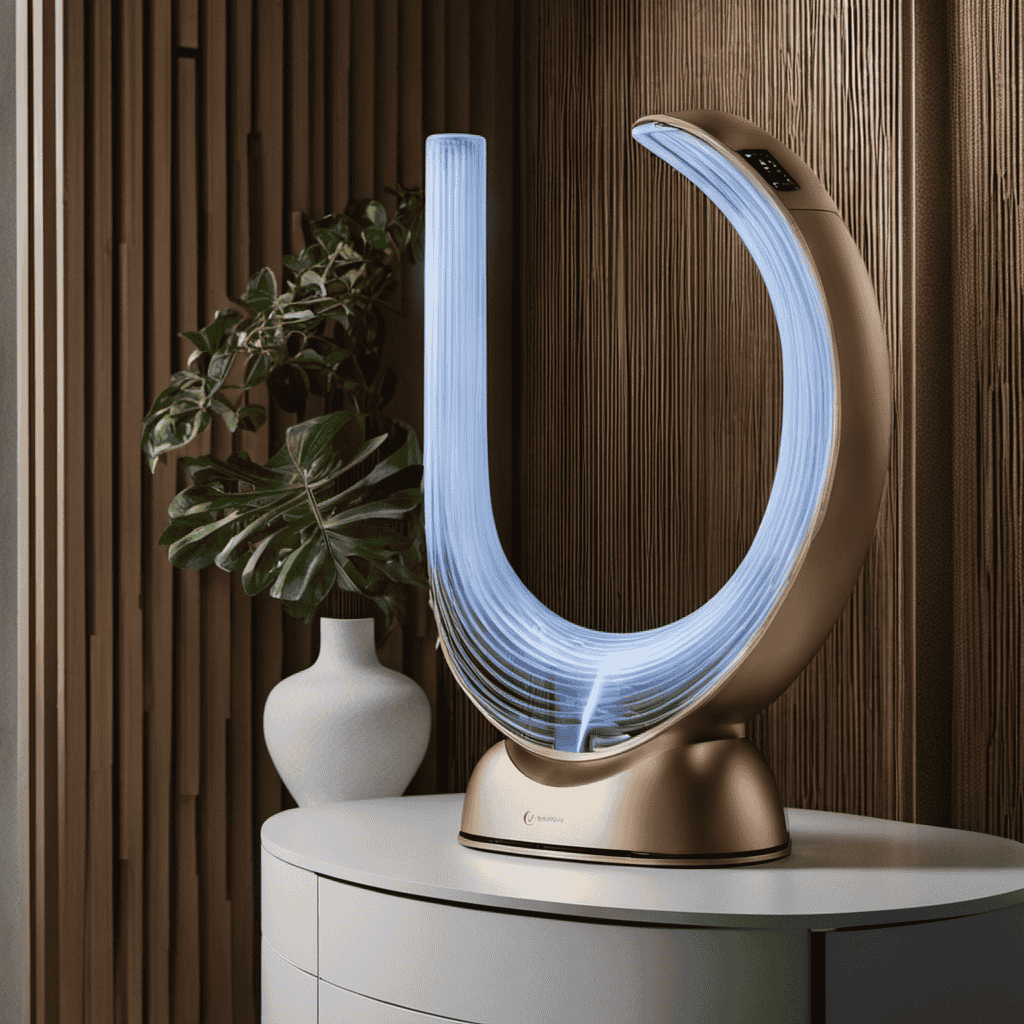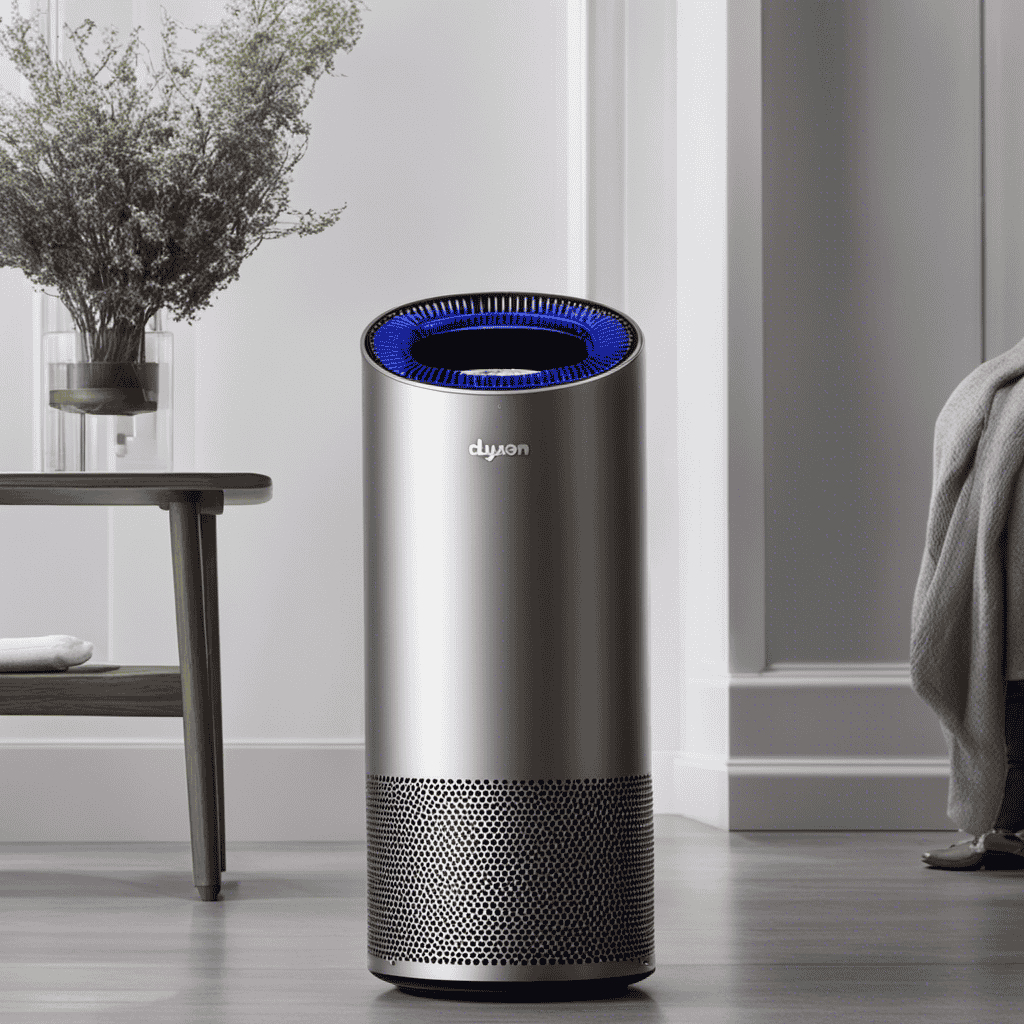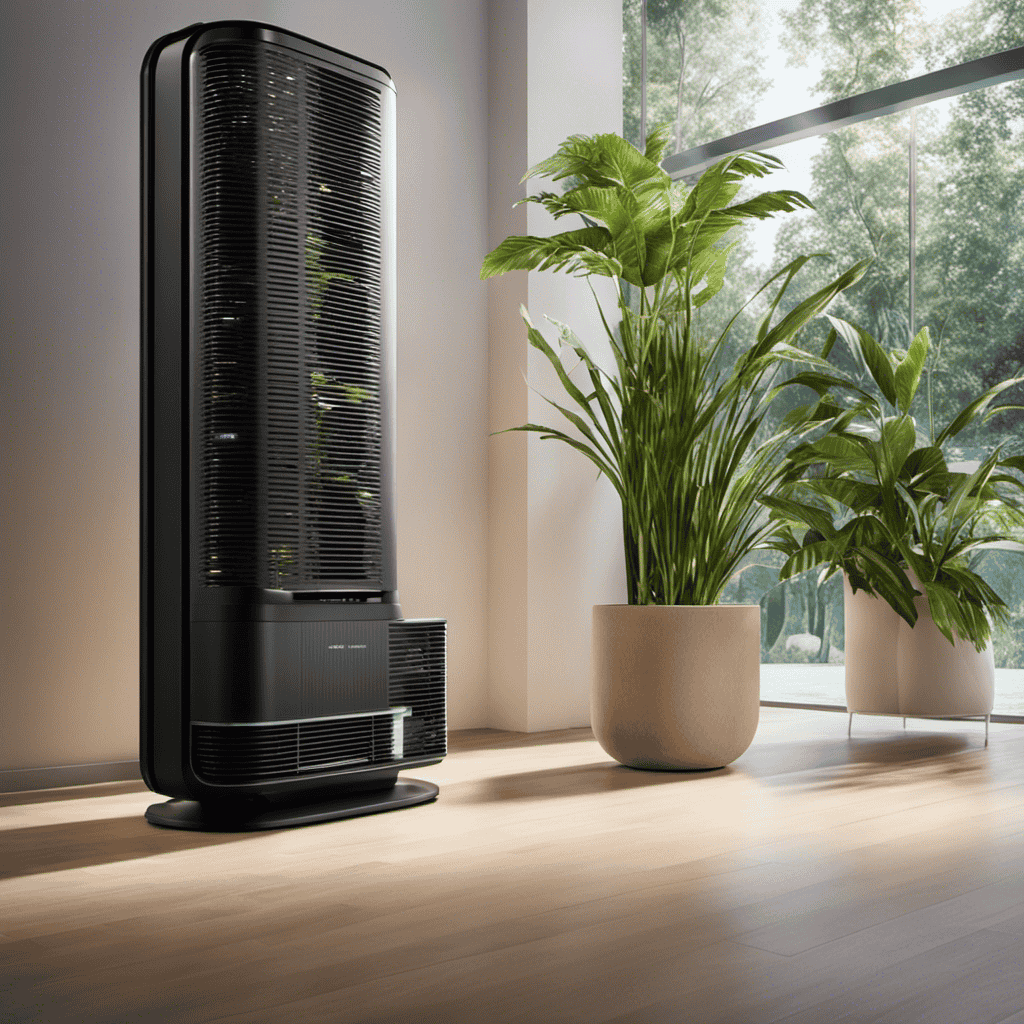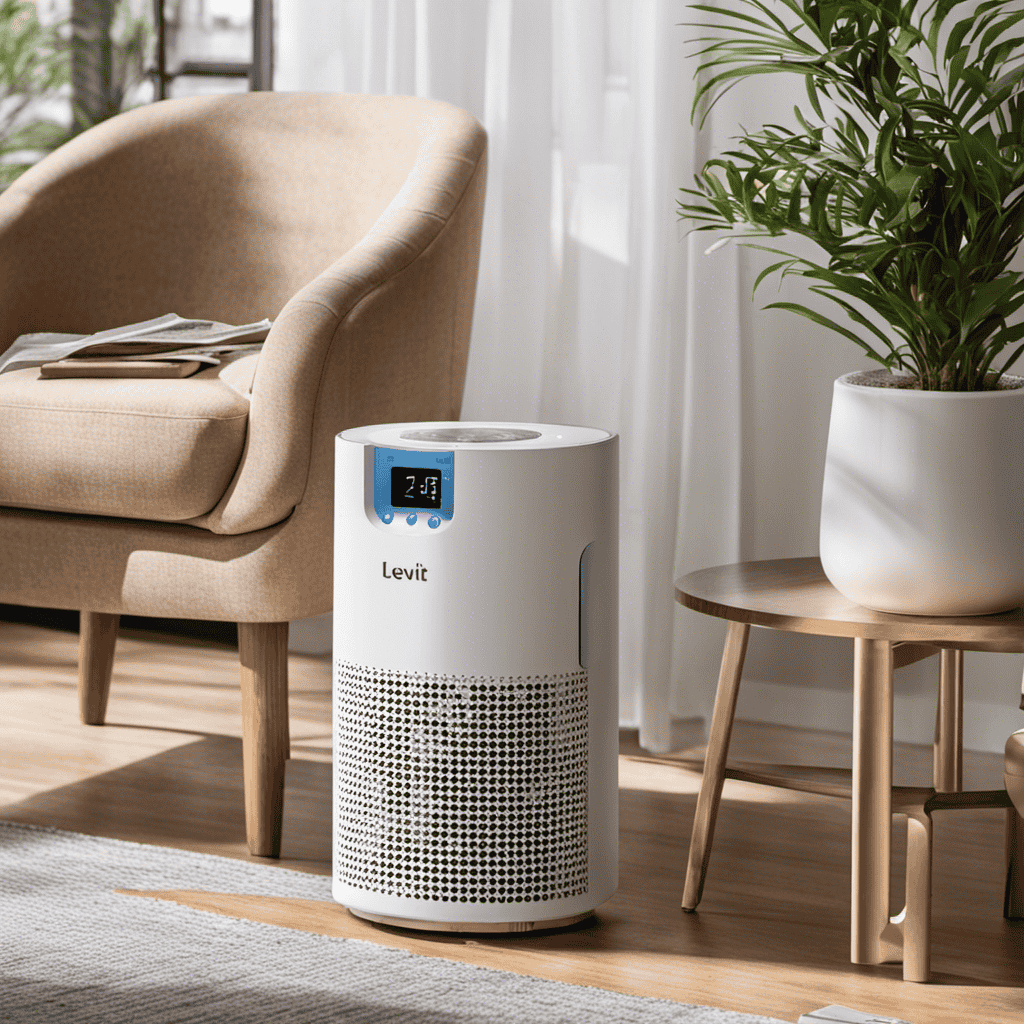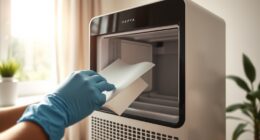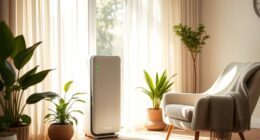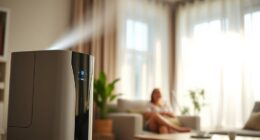I have always been intrigued by the potential of technology to enhance our daily lives.
Did you know that indoor air can be up to five times more polluted than outdoor air? That’s where ionic air purifiers come in. These innovative devices use ionization to remove airborne particles and improve the air quality in our homes.
In this article, we’ll explore the science behind how ionic air purifiers work and the benefits they provide. So let’s dive in and discover how these purifiers can make a real difference in our indoor environments.
Key Takeaways
- Ionic air purifiers use negatively charged ions to attract and remove particles from the air through electrostatic attraction.
- Ionization helps to neutralize and eliminate allergens, irritants, viruses, and bacteria in the air, improving air quality.
- These purifiers can effectively remove pollutants such as dust, pollen, pet dander, and mold spores, improving indoor air quality.
- Some models of ionic air purifiers can also neutralize odors and are more energy-efficient compared to other types of purifiers.
The Science Behind Ionic Air Purifiers
Ionic air purifiers use negatively charged ions to attract and remove particles from the air. Negative ion benefits include improving air quality by effectively capturing and eliminating pollutants such as dust, pollen, and pet dander.
These purifiers work by emitting negative ions into the air, which attach themselves to positively charged particles. This process is known as electrostatic attraction. As the negatively charged ions bind with the particles, they become too heavy to remain airborne and subsequently fall to the ground or attach to surfaces.
This mechanism effectively reduces the number of allergens and irritants present in the air, resulting in a cleaner and healthier indoor environment. Understanding ionization in air purification is crucial to fully comprehend the effectiveness and benefits of ionic air purifiers.
Understanding Ionization in Air Purification
To understand how it works, you’ll want to know more about the process of ionization in air purification. Ionization is a key principle behind the functioning of ionic air purifiers.
These devices emit positively charged ions into the air, which attach to airborne particles, such as dust, pollen, and mold spores. When the particles become charged, they are attracted to negatively charged surfaces, such as walls or furniture, and are effectively removed from the air.
This positive ionization process has several beneficial effects. Firstly, it neutralizes and eliminates allergens and irritants, improving indoor air quality. Secondly, it can reduce the presence of viruses and bacteria in the air.
Compared to other air purification methods, like filters or UV light, ionic air purifiers offer a unique approach by actively removing particles from the air using ionization.
In the next section, we will explore how ionic air purifiers specifically remove these airborne particles.
How Ionic Air Purifiers Remove Airborne Particles
When it comes to understanding how ionic air purifiers remove airborne particles, it is important to first grasp the ionization process.
Through ionization, these devices release negative ions into the air, which attach to positively charged particles, such as dust, pollen, and smoke, causing them to become heavy and fall out of the air.
This process not only improves air quality by removing these harmful particles, but it also helps to reduce allergies and respiratory issues that can be caused by them.
Ionization Process Explained
You’ll love how the ionization process in an air purifier helps to clean and freshen the air in your home. Here are the advantages and health benefits of ionization:
-
Reduction of airborne particles: When an air purifier uses ionization, it releases negative ions into the air. These ions attach to positively charged particles like dust, pollen, and pet dander, causing them to become heavier and fall out of the air, effectively reducing their presence in your home.
-
Odor elimination: Ionization can also neutralize odors by breaking down volatile organic compounds (VOCs) and other odor-causing molecules. This helps to eliminate unpleasant smells and create a fresher environment.
-
Allergy relief: Ionization can be especially beneficial for those with allergies or respiratory conditions. By reducing airborne particles and allergens, such as mold spores and bacteria, ionization can help to alleviate symptoms and improve overall respiratory health.
Incorporating ionization into your air purifier can provide numerous advantages and health benefits, making it an excellent choice for improving the air quality in your home.
Benefits of Particle Removal
By reducing the presence of dust, pollen, and pet dander in your home, ionization helps to create a cleaner and fresher environment. One of the key benefits of ionization is its ability to remove particles from the air, thus improving indoor air quality. Air purification techniques, such as ionization, play a crucial role in enhancing the overall health and well-being of individuals. The impact of these techniques on indoor air quality cannot be underestimated. To better understand this, let’s take a look at the following table:
| Particle Type | Size Range (micrometers) | Typical Sources | Health Effects |
|---|---|---|---|
| Dust | 0.001-500 | Outdoor/Indoor | Allergies, Asthma |
| Pollen | 10-100 | Plants | Allergies |
| Pet Dander | 2.5-10 | Pets | Allergies, Asthma |
As we can see, these common particles can have adverse effects on our health. By effectively removing them from the air, ionization helps to create a healthier living environment. Now, let’s dive deeper into the role of negative ions in air purification.
The Role of Negative Ions in Air Purification
To understand how negative ions work in air purification, it’s important to know that they attach to airborne particles, making them heavier and causing them to fall to the ground or be captured by a filter. Negative ions play a crucial role in improving air quality by neutralizing positive ions that are harmful to our health. Here’s how negative ions work in air purification:
-
Attraction: Negative ions are generated and released into the air by ionic air purifiers. These ions are attracted to positively charged particles such as dust, pollen, and smoke.
-
Bonding: Once the negative ions come into contact with these airborne particles, they attach to them, forming larger particles.
-
Removal: The heavier particles are then either pulled down to the ground by gravity or captured by a filter, effectively removing them from the air we breathe.
Benefits of Using Ionic Air Purifiers
Experience the benefits of using an ionic air purifier in your home, such as cleaner and fresher air for you and your family.
Ionic air purifiers are known for their effectiveness in removing airborne particles and pollutants. These devices work by emitting negative ions into the air, which attach to positively charged particles like dust, pollen, and pet dander. By doing so, the pollutants become heavier and settle down, making it easier for them to be trapped by the purifier’s filter or simply fall to the ground. This process helps to improve indoor air quality and reduce the risk of respiratory issues.
Additionally, ionic air purifiers do not produce any harmful byproducts, making them a safe and environmentally friendly choice for air purification.
Now, let’s explore some tips for choosing the right ionic air purifier for your needs.
Tips for Choosing the Right Ionic Air Purifier
When it comes to choosing the right ionic air purifier, there are several key features to consider.
These features include the type of filtration system used, the noise level, and the energy efficiency of the purifier.
Additionally, it is important to take into account the size of the room in which the purifier will be used, as different models have different coverage areas.
Lastly, regular maintenance and filter replacement are crucial to ensure the purifier continues to effectively remove pollutants from the air.
Key Features to Consider
One of the key features to consider when looking for an ionic air purifier is its ability to remove allergens from the air. This is crucial for those who suffer from allergies or asthma, as it can greatly improve their indoor air quality.
Additionally, room placement is another important factor to consider. Placing the air purifier in a central location in the room will ensure that it effectively cleans the air throughout the entire space.
Another feature to look for is energy efficiency. An energy-efficient air purifier will not only save you money on your electricity bill, but it will also reduce your carbon footprint.
Room Size Compatibility
To determine if an ionic air purifier is compatible with the size of your room, you should consider its maximum coverage area. The effectiveness of an air purifier depends on its ability to circulate and clean the air in a given space. The maximum coverage area indicates the size of the room that the purifier can effectively clean. It is important to choose an air purifier that is appropriate for your room size to ensure optimal air purification.
Additionally, consider the noise level of the purifier. Some ionic air purifiers can produce a noticeable amount of noise, which may be undesirable in certain settings. Therefore, it is important to choose a purifier that strikes a balance between air purifier effectiveness and noise level.
Transitioning into the next section, let’s now discuss the maintenance and filter replacement of an ionic air purifier.
Maintenance and Filter Replacement
Now that we understand the compatibility of the ionic air purifier with different room sizes, let’s talk about maintenance and filter replacement.
As an owner of an ionic air purifier, it’s crucial to keep it in good working condition to ensure optimal air purification. Here are some maintenance tips to follow:
-
Regular cleaning: Clean the exterior and interior of the purifier with a soft, damp cloth to remove dust and dirt buildup.
-
Filter replacement: The filters in an ionic air purifier need to be replaced periodically. The frequency of replacement varies depending on the model and usage. It’s essential to follow the manufacturer’s instructions for filter replacement.
-
Cost considerations: Before purchasing an ionic air purifier, it’s advisable to research the cost of filter replacements. Some filters are more expensive than others, so it’s important to factor in this cost when budgeting for your purifier.
Frequently Asked Questions
How Often Should I Clean the Plates in My Ionic Air Purifier?
I clean the plates in my ionic air purifier every month to maintain its efficiency. Regular cleaning helps remove dirt, dust, and other particles that accumulate on the plates, ensuring optimal performance.
Can Ionic Air Purifiers Remove Pet Dander and Odors From the Air?
Yes, ionic air purifiers can effectively remove pet dander and odors from the air. These devices use negatively charged ions to attract and neutralize allergens, while also improving overall air filtration.
Do Ionic Air Purifiers Produce Ozone?
Yes, they do. Ionic air purifiers produce ozone, which can be harmful to our health. It is important to consider the dangers of ozone and the potential health risks associated with using ionic air purifiers.
Are Ionic Air Purifiers Effective in Reducing Allergies?
I find that ionic air purifiers can be effective in reducing allergies, but their effectiveness for asthma is less clear. Compared to HEPA filters, ionic air purifiers may not be as reliable for allergies.
Can Ionic Air Purifiers Remove Viruses and Bacteria From the Air?
Yes, ionic air purifiers can remove viruses and bacteria from the air, making them effective in reducing respiratory illnesses. They also help with mold spores. Their effectiveness lies in their ability to release negative ions that attract and neutralize these harmful particles.
Conclusion
In conclusion, the use of ionic air purifiers is a scientifically proven method for improving indoor air quality. By emitting negative ions, these purifiers attract and eliminate harmful airborne particles, leaving the air fresh and clean.
With their ability to remove allergens, pollutants, and odors, ionic air purifiers are like a gentle breeze sweeping away the impurities in our homes.
When selecting an ionic air purifier, consider the size of the room and the specific needs of your household. Choose wisely and breathe easier.
